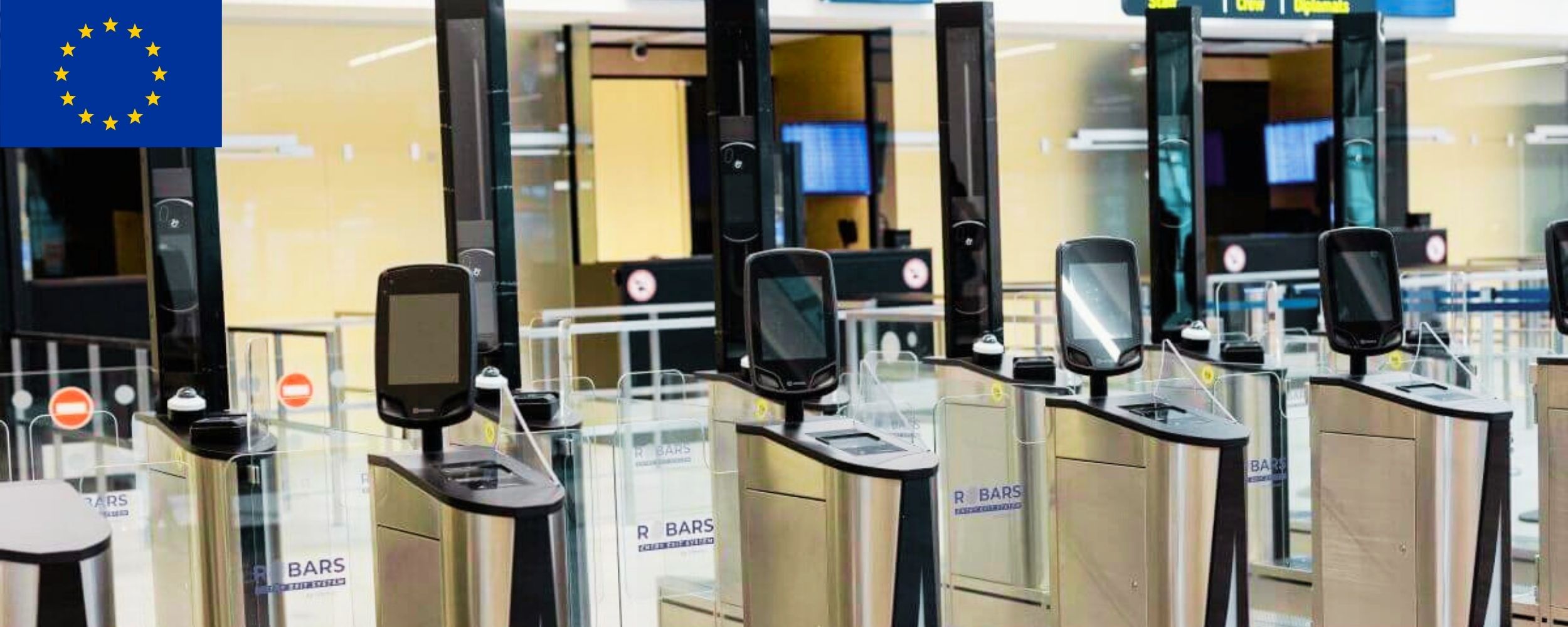- News >
- The European Entry/Exit System
The European Entry/Exit System

The European Entry/Exit System (EES) is an automated registration system that is being developed by the European Union (EU) to enhance border security and facilitate the management of non-EU travellers entering and exiting the EU member states. The system aims to record and track the entry and exit data of travellers, including their biometric information, to strengthen border control measures and improve the enforcement of immigration regulations.
Will border chaos arise due to the new European entry system?
The introduction of a new European entry system, such as the Entry-Exit System (EES) or the European Travel Information and Authorisation System (ETIAS), does have the potential to create some challenges and disruptions at border checkpoints.
However, whether or not it will lead to border chaos depends on various factors, including the implementation strategy, preparedness of border control authorities, and awareness among travellers.
Here are a few key considerations:
Transition Period:
It is crucial to allow for a transition period during the implementation of a new entry system. This allows travellers and border control personnel to become familiar with the new processes and procedures, minimising disruptions. Adequate training and support should be provided to ensure a smooth transition.
Infrastructure and Resources:
Sufficient infrastructure, such as self-service kiosks and e-gates, should be in place to handle increased volumes of travellers efficiently. Adequate staffing and resources are essential to minimise processing times and avoid bottlenecks at border crossings.
Public Awareness and Education:
Effective communication campaigns should be implemented to inform and educate travellers about the new entry system well in advance. Clear instructions and guidelines should be provided to help travellers understand the requirements and procedures, reducing confusion and potential chaos.
Cooperation among EU Member States:
Close coordination and cooperation among EU member states are crucial to ensure a harmonised approach to the new entry system. Consistency in procedures, document requirements, and processing times will help avoid confusion and disruptions at borders.
By addressing these considerations and implementing appropriate measures, the potential for border chaos can be significantly reduced. However, it is important to acknowledge that there may be some initial challenges and adjustments as the new entry system is implemented. Timely planning, effective communication, and proactive measures can help mitigate any potential disruptions and ensure a smooth transition for travellers and border control authorities.
Is the EES set to be operational?
The European Entry Exit System (EES) is now scheduled to become operational in November 2023 due to concerns raised over a lack of preparedness for the initially planned launch in May. This system is part of the broader European Travel Information and Authorisation System (ETIAS), which is set to be implemented in 2024.
The EES will introduce additional complexity for non-EU nationals visiting the European Union (EU). Under this system, visitors from outside the EU will be required to apply and pay for a visa waiver before entering any country within the Schengen zone. The visa waiver, obtained through the ETIAS application process, will grant permission for short-term stays in the Schengen Area.
European countries are preparing for these changes by ensuring their systems and infrastructure are in place to handle the implementation of the EES and ETIAS. This includes setting up the necessary technology, staff training, and establishing procedures to process visa waiver applications and enforce compliance.
To potentially avoid visa fees, travellers can explore exemptions or alternative visa options based on their nationality or specific circumstances. It is advisable to check the specific visa requirements for the countries within the Schengen Area and consult with relevant embassies or consulates for up-to-date information and guidance.
As the EES and ETIAS implementation approaches, staying informed about the changes, following official guidelines, and allowing ample time for visa application and processing will help ensure a smooth travel experience within the Schengen zone.
The EES and the ETIAS
The Entry-Exit System (EES) is a new registration system introduced by the European Union (EU) to gather additional information about non-EU travellers entering the bloc. In addition to passport details, the system will utilise automated barriers at border checkpoints to collect and store biometric data, including fingerprints and facial images.
The traditional practice of stamping passports upon entry and exit will be replaced by the EES, which will automatically record the arrival and departure of individuals in EU countries. This automated registration process will assist in identifying individuals who have exceeded their permitted stay in the EU, making it easier to monitor and flag cases of overstays.
It's important to note that the EES is applicable to non-EU citizens, including UK nationals after Brexit, who are allowed to stay in the EU for a maximum of 90 days without requiring a visa. EU citizens and individuals travelling within the Schengen zone countries are exempt from the EES requirements.
Overall, the EES aims to enhance border control measures, streamline data collection, and improve the detection and management of overstays within the EU.
Source: ETIAS France
The ETIAS application
To apply for the European Travel Information and Authorisation System (ETIAS), which will be implemented in 2024, non-EU nationals will need to follow the following steps:
1. Complete an Online Application:
Before travelling to most European countries, non-EU nationals will need to complete an online application for ETIAS. The application will require providing personal information, passport details, travel plans, and answering security-related questions.
2. Pay the Application Fee:
Upon submitting the application, a fee of €7 per person (for individuals aged between 18 and 70) will be required. The payment can be made electronically as part of the application process.
3. Wait for Approval:
The application will be processed, and once approved, the ETIAS visa will be granted. This visa will allow non-EU citizens to stay in the EU and Schengen zone for a maximum of 90 days within a 180-day period.
4. Validity Period:
Once approved, the ETIAS visa will remain valid for three years. During this period, the traveller will not need to reapply for subsequent visits to the EU or Schengen zone.
It's important to note that citizens of the Republic of Ireland and individuals with official residency in an EU country, holding a biometric identity card (such as the carte de séjour in France or the carta di soggiorno in Italy), may be exempt from the ETIAS requirements and the 90-day limit on stays.
While the exact launch date of ETIAS is not yet confirmed, it is expected to be introduced approximately five to six months after the implementation of the Entry-Exit System (EES). During the implementation period, the system may be gradually introduced alongside the EES.
What will the EES barriers look like?
The specific design and appearance of the Entry-Exit System (EES) barriers can vary depending on the implementation by different border control authorities. However, generally, the EES barriers are expected to include automated systems and devices for the registration of travellers' entry and exit data. Here are some common features and components that may be present in the EES barriers:
1. Self-Service Kiosks:
EES barriers may include self-service kiosks where travellers can scan their passports or travel documents to initiate the registration process. These kiosks may be equipped with touchscreens or scanning devices to capture the necessary data.
2. Biometric Data Collection:
EES barriers are designed to collect biometric data such as fingerprints and facial images. The barriers may include specialised scanners or cameras to capture and store this information securely.
3. Travel Document Authentication:
EES barriers are likely to include mechanisms for authenticating travel documents. These may involve advanced technologies such as optical character recognition (OCR) to read and verify the information on passports or travel documents.
4. Integration with Central Database:
The EES barriers will be connected to a central database where the collected data is stored and processed. This integration ensures that the entry and exit information is accurately recorded and accessible for border control and immigration authorities.
5. E-Gates or Border Control Officer Stations:
Depending on the specific implementation, EES barriers may feature e-gates or manned stations where border control officers can conduct additional checks or assist travellers as needed. This allows for a combination of automated processes and human oversight.
The aim is to create efficient and secure systems that streamline the registration process while ensuring accurate data collection and compliance with immigration regulations.
How to avoid the ETIAS scams

To avoid falling victim to ETIAS scams, it's important to be vigilant and follow these tips:
1. Use Official Channels:
Only use the official ETIAS website or government-approved platforms to apply for an ETIAS visa waiver. Avoid third-party websites or unauthorised agents, as they may be fraudulent and aim to deceive you.
2. Verify Website Authenticity:
Before entering any personal or payment information, ensure that the website you are using has a secure connection (look for "https://" and a padlock icon in the address bar). Double-check the web address to ensure it matches the official ETIAS website.
3. Be Wary of Unsolicited Communications:
Be cautious of unsolicited emails, messages, or phone calls claiming to offer expedited processing or special deals for ETIAS. Legitimate authorities will not contact you out of the blue and request payment or personal information.
4. Research Official Fees:
Familiarise yourself with the official fees associated with the ETIAS application process. If a website or agent charges significantly more than the official fee, it could be a scam.
5. Protect Personal Information:
Avoid sharing personal or financial details with unverified sources. Only provide sensitive information on secure and trusted platforms during the official application process.
6. Stay Informed:
Keep up-to-date with official announcements and information regarding the ETIAS program through reputable sources, such as government websites or trusted news outlets. This will help you stay aware of any changes or updates and avoid misinformation.
7. Report Suspicious Activity:
If you come across any suspicious websites, emails, or individuals attempting to deceive you regarding ETIAS, report it to the appropriate authorities. This can help prevent others from falling victim to scams.
By staying informed, using official channels, and exercising caution, you can reduce the risk of falling prey to ETIAS scams and ensure a secure and legitimate application process.
